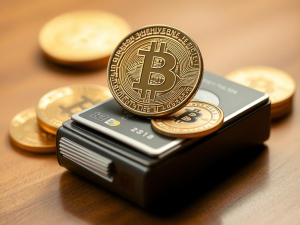
Prioritize the security of your mobile cryptocurrency wallet by implementing two-factor authentication (2FA) and keeping your software updated. These steps significantly reduce the risk of unauthorized access and ensure that your transactions remain private.
The integration of advanced technology in mobile wallets offers unparalleled convenience for managing cryptocurrency assets. However, this convenience comes with inherent risks. Regularly auditing transaction history for any suspicious activity is essential to maintain the integrity of your funds.
Encryption plays a pivotal role in safeguarding sensitive data stored within these wallets. Opt for wallets that utilize robust encryption protocols, which protect against potential breaches and enhance overall privacy. Additionally, consider using hardware wallets for large amounts of cryptocurrency, as they provide an extra layer of security beyond what mobile applications can offer.
Stay informed about recent developments in wallet technology, as updates often address vulnerabilities that could compromise user security. Understanding the balance between accessibility and protection is key to successfully navigating the mobile cryptocurrency ecosystem.
Choosing Secure Wallet Options
Select wallets that incorporate multi-factor authentication (MFA) to enhance security. This adds an extra layer of protection, requiring users to verify their identity through multiple methods before accessing their funds.
Opt for hardware wallets when dealing with significant amounts of cryptocurrency. These offline devices store private keys securely, minimizing exposure to potential online threats and ensuring that transactions remain safe from unauthorized access.
Evaluate the wallet’s encryption standards. High-quality mobile wallets should use strong encryption protocols to protect sensitive information and transaction data, safeguarding user privacy effectively.
Consider the reputation of the wallet provider. Research user reviews and ratings, focusing on those who prioritize security updates and customer support, which are crucial for addressing vulnerabilities promptly.
Examine the wallet's backup options. A reliable wallet should offer seamless backup procedures, allowing users to recover their funds in case of device loss or failure while maintaining safety during transactions.
Prioritize wallets that allow you to control your private keys. Custodial wallets may offer convenience but often compromise security by storing private keys on third-party servers, increasing risks associated with hacking.
Ensure that the wallet regularly updates its software. Frequent updates indicate active maintenance against emerging threats and vulnerabilities in mobile technology, contributing to overall safety in managing cryptocurrency assets.
Investigate any additional features such as biometric authentication or spending limits that can bolster security without sacrificing convenience during everyday transactions.
Implementing Strong Authentication Methods
Utilize multi-factor authentication (MFA) to enhance the security of mobile cryptocurrency wallets. By combining something you know (like a password) with something you have (such as a smartphone for an OTP), you significantly reduce the risk of unauthorized access during transactions.
Incorporate biometric authentication methods, such as fingerprint or facial recognition, which offer both convenience and safety. These technologies provide a robust layer of security that is difficult for malicious actors to bypass.
Regularly update your authentication methods to keep pace with advancements in technology. This includes changing passwords frequently and using complex combinations that resist brute-force attacks.
Consider implementing hardware security modules (HSMs) if your mobile wallet provider supports them. HSMs securely store cryptographic keys, making it harder for attackers to gain access to sensitive information related to your cryptocurrency assets.
Educate users about phishing attacks that target authentication credentials. Encourage vigilance when accessing wallets through public networks or unfamiliar devices, as these can be points of compromise.
Evaluate wallet applications for their support of advanced authentication features. Opt for wallets that prioritize security measures and regularly undergo third-party audits to ensure compliance with best practices in safety.
Finally, maintain regular backups of your wallet and associated credentials in secure locations. This practice not only aids recovery but also ensures continuous access without compromising on security protocols.
Recognizing Phishing Attacks
To enhance security while using mobile cryptocurrency wallets, recognize phishing attacks by following these guidelines:
- Check URLs: Always verify that the website address begins with "https://" and matches the official wallet provider. Phishing sites often mimic legitimate ones but use slight variations in spelling.
- Email Caution: Be skeptical of unsolicited emails requesting sensitive information. Legitimate companies never ask for your private keys or passwords via email.
- Look for Red Flags: Watch for poor grammar, unusual sender addresses, or generic greetings in communications. These can indicate phishing attempts.
- Two-Factor Authentication (2FA): Utilize 2FA wherever possible. Even if credentials are compromised, an additional verification step can prevent unauthorized access.
- Phishing Links: Hover over links before clicking to see their true destination. Avoid clicking on links from unverified sources.
By maintaining vigilance against phishing threats, you can protect your privacy and ensure the safety of your transactions within the mobile cryptocurrency ecosystem.
Stay informed about common phishing tactics and regularly update your knowledge on security practices to enhance overall protection.
Regularly Updating Security Features
Ensure that your mobile cryptocurrency wallet includes regular updates to its security features. This practice enhances safety and mitigates vulnerabilities that could be exploited by malicious actors. Look for wallets that provide automatic updates or notifications when new versions become available.
Many wallet providers release patches in response to newly discovered threats, ensuring the protection of user privacy. Regular updates should include improvements in encryption protocols, bug fixes, and enhancements in two-factor authentication methods.
Users must actively engage with their wallet's update process. Check settings for automatic updates and enable them if available. If manual updates are required, schedule periodic checks–ideally every month–to ensure that you are using the latest version. Keeping your mobile device's operating system up to date is equally important as vulnerabilities can arise from outdated software.
Additionally, consider using wallets that incorporate multi-signature technology, which adds another layer of security. Each transaction would require multiple approvals before being processed, significantly reducing the risk of unauthorized access.
Stay informed about any reported security incidents related to your chosen wallet provider. Being proactive about these developments allows you to make timely decisions about switching wallets or enhancing your security measures further.

You can be the first!